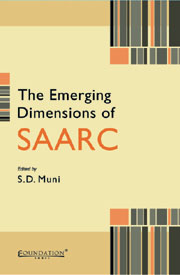Book contents
- Frontmatter
- Contents
- Preface
- List of Figures
- List of Tables
- 1 SAARC Prospects: The Changing Dimensions
- 2 SAARC and South Asian Economic Integration
- 3 Coping with the Emerging Challenges: Poverty and Food Security
- 4 SAARC Energy Cooperation: Energy Security and Environmental Challenges
- 5 Sub-Regional Cooperation under SAARC: An Economic Analysis
- 6 SAARC: Social Charter and Human Security
- 7 SAARC and the South Asian Security Architect
- 8 Fighting Terrorism through SAARC?
- 9 SAARC and the Evolving Asian Regionalism
- 10 Role of SAARC Observers: Members' Perspectives
- 11 Role of SAARC Observers: Observers' Perspectives
- 12 Concluding Remarks
- About the Contributors
- Index
7 - SAARC and the South Asian Security Architect
Published online by Cambridge University Press: 26 October 2011
- Frontmatter
- Contents
- Preface
- List of Figures
- List of Tables
- 1 SAARC Prospects: The Changing Dimensions
- 2 SAARC and South Asian Economic Integration
- 3 Coping with the Emerging Challenges: Poverty and Food Security
- 4 SAARC Energy Cooperation: Energy Security and Environmental Challenges
- 5 Sub-Regional Cooperation under SAARC: An Economic Analysis
- 6 SAARC: Social Charter and Human Security
- 7 SAARC and the South Asian Security Architect
- 8 Fighting Terrorism through SAARC?
- 9 SAARC and the Evolving Asian Regionalism
- 10 Role of SAARC Observers: Members' Perspectives
- 11 Role of SAARC Observers: Observers' Perspectives
- 12 Concluding Remarks
- About the Contributors
- Index
Summary
Dimensions of Security
External security threat perceptions with politico-ideological and military undertones were among the factors influencing the creation of the Association of South East Asian Nations (ASEAN) in the 1960s. As the Singapore Minister of Defence, Teo Chee Hean commented on 3 June 2007 at the 7th International Institute of Strategic Studies (IISS), Asian Security Summit (the Shangri-La Dialogue) in Singapore, ‘the original ASEAN 6 (Brunei, Indonesia, Malaysia, Philippines, Singapore and Thailand) were all anti-Communist and sought close ties with the West’. However, only Philippines and Thailand (and Pakistan from South Asia) were among signatories to the South East Asia Collective Defence Treaty in 1954 leading to the establishment of the anti-Communist South East Asia Treaty Organisation (SEATO) which was dissolved by 1977. At the Bali Summit in October 2003, ASEAN Concord II was signed announcing the concept of ASEAN as a Security Community.
On the other hand, in the neighbouring region of South Asia, at its first Summit in 1985, the ‘fundamental goal’ of the SAARC, in accordance with its founding Charter, was declared to be ‘accelerating economic and social development’. Perestroika was gradually emerging in Moscow by then and rigid ideological confrontations were easing. All seven founder member states of SAARC were also members of the Non-Aligned Movement.
At the same time, for most of the South Asian states there certainly were security concerns, though not primarily of an external nature.
- Type
- Chapter
- Information
- The Emerging Dimensions of SAARC , pp. 154 - 176Publisher: Foundation BooksPrint publication year: 2010



